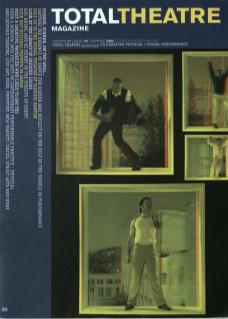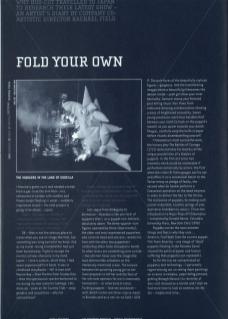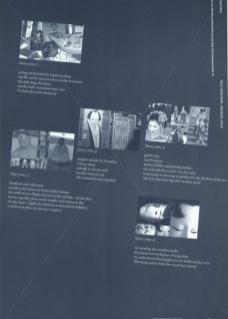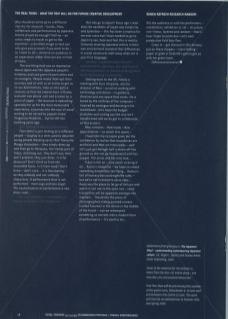The Voyagers in the Land of Godzilla
I fancied a green curry and needed a break from a get-in at the Drill Hall – in a restaurant in London with candles and flower heads floating in water – suddenly inspiration struck – the next project is going to be about... Japan.
Aware: the Japanese feeling of compassion, patience, and pity; felt especially towards the beauty of that which is transitory or ephemeral.
OK – that is not the obvious place to travel when you see an image like that, but something was lying buried in my head. And as my travel-loving Grandmother had just been buried away, flight to escape the mortal coil was obviously in my mind. Japan – I love a culture, which then, I had never experienced first hand. It was in childhood storybooks – fell in love with Marine Boy – then Thelma from Scooby Doo – then the spectacular spectre beckoned to me during my new romantic teenage. Let’s dress up-pose at the Country Club – swap genders and sexualities – why not nationalities?
Aimai: ambiguity, used as a way of avoiding open confrontation in Japanese communication; aimai-na: the adjectival form of aimai; aimai-na kotobar: ambiguous language.
Let’s segue from Ambiguity to Animation – Bunraku is the one form of puppetry that I, as a puppet non-believer, absolutely adore. The three-quarter-size figures are operated by three (men mostly); the older and most experienced puppeteer, who controls head and one arm, reveals his face with the other two puppeteers controlling other limbs shrouded in hoods. So when lovers are committing joint suicide – two old men hover over the image like taut otherworldly onlookers on the immensely emotional scene. The tension between the quivering young girl as her lover prepares to kill her and the face of her old male operator for me is immensely homoerotic – or some kind of erotic. Fucking puppets – love sex and death – well, death scenes are three-course meals in Bunraku and as a not-so-ex Goth I LOVE IT. The pale faces of the beautifully stylised figures are gorgeous. And the transforming images where a beautiful girl becomes the demon inside – yeah girl show your inner bestiality. Samurai stamp your frenzied post killing ritual. Hair flows from elaborate dressing and decoration, showing scenes of heightened sensuality. Sweet young prostitute catch that handkerchief between your teeth (a hook on the puppet’s mouth) as you quiver towards your death. Shogun, carefully wrap the knife in paper before ritually disembowelling yourself.
‘Chikamatsu’s most successful work, the history play The Battles of Coxinga (1715) demonstrates his mastery of the unique possibilities of a theatre of puppets. In the first act occur two moments which would be intolerable if performed realistically by actors: the first when the villain Ri Toten gouges out his eye and offers it on a ceremonial baton to the Tartar envoy as a pledge of fealty, the second when Go Sankei performs a Caesarean operation on the dead empress in order to deliver the heir to the throne. The stylisation of puppets, by making such scenes endurable, touches springs of pity and terror forbidden to actors.’ (From the Introduction to Major Plays Of Chikamatsu, translated by Donald Keene, Columbia University Press, New York 1961/1990.)
Puppets can do the most extreme things and that is why they rock... America, Fuck Yeah (see the current puppet film Team America – one image of ‘dead’ puppets floating in the Panama Canal showed the political power and human suffering that puppetry can represent).
So for the trip we concentrated on puppetry and technology – I personally regret missing out on seeing more paintings on screens in temples, paper being pressed, getting Nenagh Watson (co-director of doo-cot) dressed as a Geisha and I wish we had more time to look at cameras etc etc etc – maybe next time…
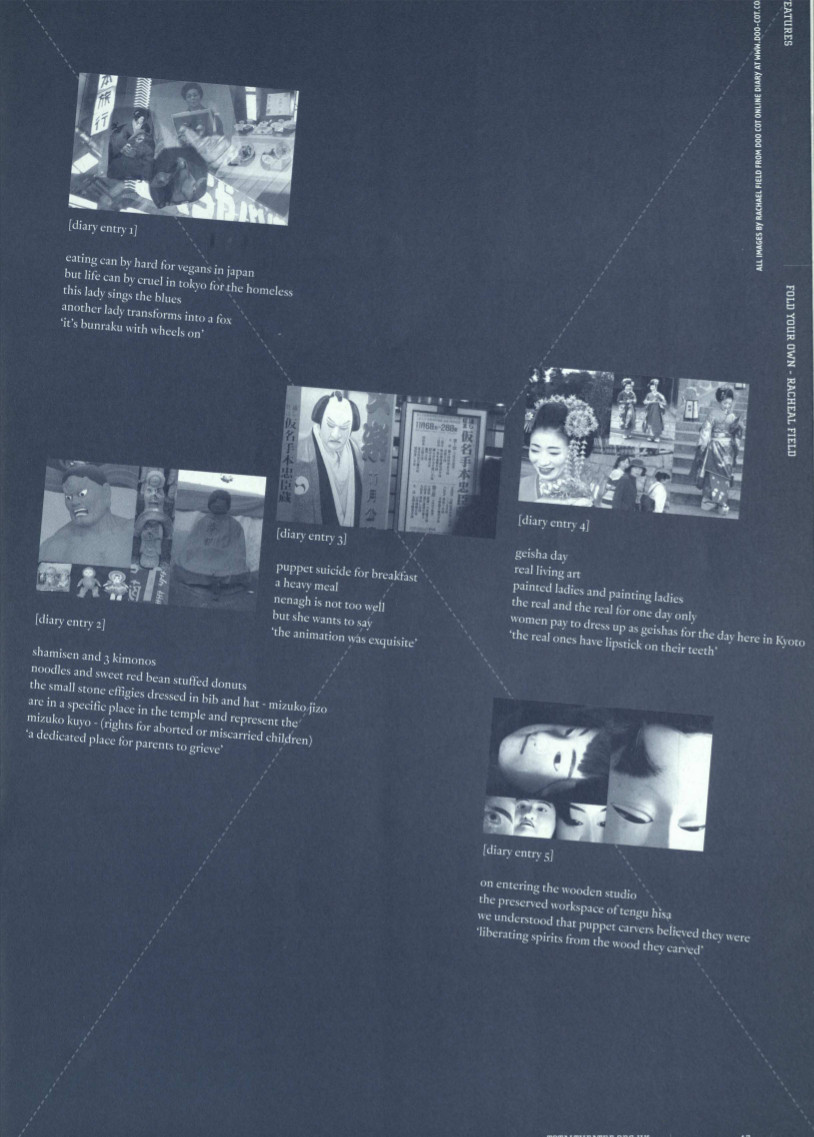
The Real Thing – What the Trip Will Do For Future Creative Development
Why should an artist go to a different country for research – books, films, exhibitions and performances by Japanese artists should be enough? Hell no – an artist needs to travel to get to the essential; a distilled image or text can only give you so much if you want – as I want – to immerse an audience in an experience rather than act out in front of them.
The one thing that was so impressive about Japan was the Japanese people’s kindness and care given to each other and to strangers. People would interrupt their journeys and sit with us on trains to get us to our destinations, take us into police stations to find the lesbian bars in Osaka and with one phone call and a name on a piece of paper – the museum is opened up specially for us for the most memorable experience, a journey into the soul of wood waiting to be carved by puppet maker Tenguhisa Hisakichi... but he left the building years ago.
Giri: feeling of obligation to others.
Then there is just looking at a different people – Cosplay is a term used to describe young people dressing up as their favourite Manga characters – they simply dress up and then go to Harajuku, the trendy part of Tokyo, and hang out. They don’t act, they don’t pretend, they just dress. Is it for pleasure? Don’t think so from the miserable faces. Is it from need? Don’t know – don’t care... it is fascinating as they embody and not-embody characters. A performance that is not performed – more wigs and less angst. The neutralisation of performance, a new dress code...
Mu: non existence or emptiness; a central principle in Zen Buddhism
But why go to Japan? Years ago I read that the aesthetic of Japan was simplicity and splendour – this has been a mantra for me ever since but I have needed to go to Japan to see, hear and feel this in reality. Certainly meeting Japanese artists in their own environment revealed that differences in social constructs melt away when art is your first language.
Gambari: Japanese patience and determination; gambaru: the verb form of the noun gambari, or the act of doing one’s best and hanging on patiently.
Getting back to the UK, finally a meeting with Yuzo Ishiyama, artistic director of Nest – an artist working with technology and dance – in galleries, theatres and any space that works. He is bored by the confines of the computer – inspired by analogue and dancing is his sketchbook. Let’s hope the budget stretches and sorting out the visa isn’t complicated and we do get to collaborate on this project
New contacts – New leads – New opportunities – so watch this space...
I hope the trip to Japan gives me the confidence to realise that boundaries are artificial and that art transcends – well let’s just get Nenagh half a metre off the ground so she can go heavenward with her puppet. The artist and her only love...
Tokyo is full on – just watch us bring it on... Kyoto is beautiful – we hope to create something beautifully terrifying... Osaka is full of hostess bars and nightlife rules – but we're not licensed to serve sake... Awaji was the place to let go of the sun and watch it sail out to the open sea – some tranquillity will be apparent amongst the mayhem... Tokushima the place of choreographed sliding painted screens (called Fusuma) in the shrine in the middle of the forest – can we reinterpret something so ancient into a modern form of performance – it’s worth a try...
Renew Refresh Research Random
Mix the audience in with the performers – installation, exhibition or set – structure non-linear, layered and random – that’s how I hope to paint doo-cot’s next production Fold Your Own.
Come in – get dressed in this kimono, put on these slippers – start folding paper or gods or Godzilla’s gonna get ya with her green laser.
ZAPVVVVVVVVVVVVVVV
Definitions from glossary in: The Japanese Mind – understanding contemporary Japanese culture. Ed. Roger J. Davies and Osamu Ikeno. Tuttle Publishing, 2002. Some of the material for this feature is taken from the doo-cot online diary, see www.doo-cot.com/project/diary.html Fold Your Own will be previewing this summer at the Green Room, Manchester 9-10 June and at Colchester Arts Centre 15 June. The work will then be on national tour in autumn 2005 and spring 2006.
